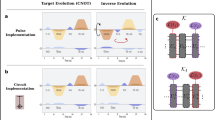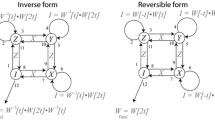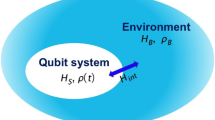Abstract
A Physical Error Estimation Tool (PEET) is introduced in Matlab for predicting physical gate errors of quantum information processing (QIP) operations by constructing and then simulating gate sequences for a wide variety of user-defined, Hamiltonian-based physical systems. PEET is designed to accommodate the interdisciplinary needs of quantum computing design by assessing gate performance for users familiar with the underlying physics of QIP, as well as those interested in higher-level computing operations. The structure of PEET separates the bulk of the physical details of a system into Gate objects, while the construction of quantum computing gate operations are contained in GateSequence objects. Gate errors are estimated by Monte Carlo sampling of noisy gate operations. The main utility of PEET, though, is the implementation of QuantumControl methods that act to generate and then test gate sequence and pulse-shaping techniques for QIP performance. This work details the structure of PEET and gives instructive examples for its operation.



Similar content being viewed by others
References
Nielsen, M.A., Chuang, I.L.: Quantum Computation and Quantum Information. Cambridge Univeristy Press, Cambridge (2000)
Shor, P.W.: Polynomial-time algorithms for prime factorization and discrete logarithms on a quantum computer. SIAM J. Comput. 26(5), 1484–1509 (1997)
Grover, L.K.: A fast quantum mechanical algorithm for database search. In: Proceedings of the 28th Annual ACM Symposium on the Theory of Computing (STOC), May 1996, pp. 212–219
Green, A.S., Lumsdaine, P.L., Ross, N.J., Selinger, P., Valiron, B.: Quipper: a scalable quantum programming language. CoRR. arXiv:1304.3390
Intelligence advanced research projects activity (iarpa): Quantum Computer Science (QCS) Program
Devitt, S.J., Stephens, A.M., Munro, W.J., Nemoto, K.: Requirements for fault-tolerant factoring on an atom-optics quantum computer. Nat. Commun. 4, 10 (2013)
Suchara, M., Faruque, A., Lai, C.Y., Paz, G., Chong, J., Kubiatowicz, J.: arXiv:1312.2316, 17 pp (2013)
Clark, C.R., Metodi, T.S., Gasster, S.D., Brown, K.R.: Resource requirements for fault-tolerant quantum simulation: the ground state of the transverse using model. Phys. Rev. A 79, 062314 (2009)
Jones, N.C., Van Meter, R., Austin, G.F., Peter L, M.M., Jungsang, K., Thaddeus D, L., Yoshihisa, Y.: Layered architecture for quantum computing. Phys. Rev. X 2, 031007 (2012)
Johansson, J.R., Nation, P.D., Nori, F.: Qutip 2: a python framework for the dynamics of open quantum systems. Comput. Phys. Commun. 184(4), 1234–1240 (2013)
Johansson, J.R., Nation, P.D., Nori, F.: Qutip: an open-source python framework for the dynamics of open quantum systems. Comput. Phys. Commun. 183(8), 1760–1772 (2012)
Quantiki.org. List of qc simulators.(2015)
Brif, C., Chakrabarti, R., Rabitz, H.: Control of quantum phenomena: past, present and future. N. J. Phys. 12(7), 075008 (2010)
Viola, L., Knill, E., Lloyd, S.: Dynamical decoupling of open quantum systems. Phys. Rev. Lett. 82, 2417–2421 (1999)
Khodjasteh, K., Viola, L.: Dynamically error-corrected gates for universal quantum computation. Phys. Rev. Lett. 102, 080501 (2009)
Viola, L., Lloyd, S.: Dynamical suppression of decoherence in two-state quantum systems. Phys. Rev. A 58, 2733–2744 (1998)
Khodjasteh, K., Viola, L.: Dynamical quantum error correction of unitary operations with bounded controls. Phys. Rev. A 80, 032314 (2009)
Kabytayev, C., Green, T.J., Khodjasteh, K., Biercuk, M.J., Viola, L., Brown, K.R.: Robustness of composite pulses to time-dependent control noise. Phys. Rev. A 90, 012316 (2014)
Khodjasteh, K., Bluhm, H., Viola, L.: Automated synthesis of dynamically corrected quantum gates. Phys. Rev. A 86, 042329 (2012)
Ho, T.-S., Dominy, J., Rabitz, H.: Landscape of unitary transformations in controlled quantum dynamics. Phys. Rev. A 79, 013422 (2009)
Rabitz, H., Hsieh, M., Rosenthal, C.: Landscape for optimal control of quantum-mechanical unitary transformations. Phys. Rev. A 72, 052337 (2005)
Hsieh, M., Rabitz, H.: Optimal control landscape for the generation of unitary transformations. Phys. Rev. A 77, 042306 (2008)
Hsieh, M., Rebing, W., Rabitz, H.: Topology of the quantum control landscape for observables. J. Chem. Phys. 130(10), 104109 (2009)
Rabitz, H., Ho, T.-S., Hsieh, M., Kosut, R., Demiralp, M.: Topology of optimally controlled quantum mechanical transition probability landscapes. Phys. Rev. A 74, 012721 (2006)
Kosut, R.L., Grace, M.D., Brif, C.: Robust control of quantum gates via sequential convex programming. Phys. Rev. A 88, 052326 (2013)
Suzuki, M.: General theory of higher-order decomposition of exponential operators and symplectic integrators. Phys. Lett. A 165, 387–395 (1992)
Merrill, J.T., Brown, K.R.: Progress in Compensating Pulse Sequences for Quantum Computation. Wiley, New York (2014)
Dawson, C.M., Nielsen, M.A.: The Solovay-Kitaev algorithm. Quant. Inf. Comp. 6, 81–95 (2006)
Bruer, H.-P.: The Theory of Open Quantum Systems. Oxford University Press, Oxford (2002)
Brockwell, P.J., Davis, R.J.: Introduction to Time Series and Forecasting, 2nd edn. Springer, New York (2002)
Hocker, D., Brif, C., Grace, M.D., Donovan, A., Ho, T.-S., Tibbetts, K.M., Wu, R., Rabitz, H.: Characterization of control noise effects in optimal quantum unitary dynamics. Phys. Rev. A 90, 062309 (2014)
Sorber, L., Kron: MATLAB Central File Exchange. Retrieved 2013 (2011)
Iglin, S.: Grtheory. 2004. MATLAB Central File Exchange. Retrieved (2013)
Tibbetts, K.W.M., Brif, C., Grace, M.D., Donovan, A., Hocker, D.L., Ho, T.-S., Wu, R.-B., Rabitz, H.: Exploring the tradeoff between fidelity and time optimal control of quantum unitary transformations. Phys. Rev. A 86, 062309 (2012)
Rothman, A., Ho, T.-S., Rabitz, H.: Observable-preserving control of quantum dynamics over a family of related systems. Phys. Rev. A 72, 023416 (2005)
Rothman, A., Ho, T.-S., Rabitz, H.: Exploring the level sets of quantum control landscapes. Phys. Rev. A 73, 053401 (2006)
Moore, K.W., Chakrabarti, R., Riviello, G., Rabitz, H.: Search complexity and resource scaling for the quantum optimal control of unitary transformations. Phys. Rev. A 83, 012326 (2011)
Rabitz, H.A., Hsieh, M.M., Rosenthal, C.M.: Quantum optimally controlled transition landscapes. Science 303(5666), 1998–2001 (2004)
Khodjasteh, K., Lidar, D.A., Viola, L.: Arbitrarily accurate dynamical control in open quantum systems. Phys. Rev. Lett. 104, 090501 (2010)
Hocker, D., Zheng, Y., Kosut, R., Brun, T., Rabitz, H.: Survey of control performance in quantum information processing. Quant. Inf. Proc. (submitted)
Saffman, M., Walker, T.G., Mølmer, K.: Quantum information with rydberg atoms. Rev. Mod. Phys. 82, 2313–2363 (2010)
Saffman, M., Walker, T.G.: Analysis of a quantum logic device based on dipole-dipole interactions of optically trapped rydberg atoms. Phys. Rev. A 72, 022347 (2005)
Schwabl, F.: Quantum Mechanics, 3rd edn. Springer, Berlin (2002)
Stark, H., Woods, J.W.: Probability, Random Processes, and Estimation Theory for Engineers. Prentice Hall, Englewood Cliffs, NJ (1986)
Acknowledgments
This material is based upon work supported by the (D.H.) National Science Foundation Graduate Research Fellowship Program under Grant No. (DGE 1148900), (H.R.for the basic concepts) National Science Foundation (CHE-1058644) and (R.K.) ARO-MURI (W911NF-11-1-2068). This work was also supported by the (R.K.) (H.R. for the illustrations) Intelligence Advanced Research Projects Activity (IARPA) via Department of Interior National Business Center Contract No. D11PC20165. The US Government is authorized to reproduce and distribute reprints for Governmental purposes notwithstanding any copyright annotation thereon. The views and conclusions contained herein are those of the authors and should not be interpreted as necessarily representing the official policies or endorsements, either expressed or implied, of IARPA, DoI/NBC, or the US Government.
Author information
Authors and Affiliations
Corresponding author
Additional information
This article is part of topical collection on Quantum Computer Science.
Electronic supplementary material
Below is the link to the electronic supplementary material.
Appendix
Appendix
1.1 Gate and GateSequence properties and methods
See Table 6.
1.2 Calculation of the process matrix
Propagation to calculate \(\chi _{{\mathcal {E}}}\) is performed by first transforming Eq. (1) into a set of differential equations for the matrix elements of \(\rho \) in Liouville space. This restructures the system dynamics into a Hilbert space of dimension \(N^2\) and allows for succinct calculation of process matrices through an evolution superoperator \({\mathcal {L}}\). First, vectorizing \(\rho \) columnwise to \(\mathbf {\rho }\) yields [29],
By observing the action of operators M on \(\rho \), analogous operations transform upon this vectorization to
and the Linblad equation can be reformulated as
The density matrix \(\mathbf {\rho }(t)\) is calculated by exponentiation of the time-dependent superoperator \({\mathcal {L}}(t)\) as
where \({\hat{\mathcal {T}}}\) is the time-ordering operator [43]. Gate operation dynamics are discretized over \(N_t\) points on an interval of [0, T] with resolution \(\varDelta t\). For reasonably small \(\varDelta t\), short-time propagation methods accurately describe propagation of \(\mathbf {\rho }\),
where the initial process matrix propagator is the \(N^2 \times N^2\) identity
The process matrix propagates to yield \(\mathbf {\rho }(T)\) , and its final-time form used in J is simply
1.3 Noise generation
Generating random instances of noise following a given noise correlation function are generated in PEET with a Karhunen-Loéve (KL) filter [44]. Representing a disturbance \(\delta \beta (t)\) over discrete time points \(t_i\) for \(i = 1,2,... N_t\) , the finite-dimensional noise correlation matrix \(R(t_i,t_j)\) is first diagonalized,
where M is an orthonormal matrix with column vectors being the eigenvectors of R and \(\varLambda \) is the diagonal eigenvalue matrix. The correlation matrix of a random time vector \(\mathbf {x}\) (i.e., Matlab’s rand routine) drawn from a normal distribution of zero mean and standard deviation equal to 1 is given by a delta function, \(R_x(t_i,t_j) = \langle \mathbf {x}(t_i),\mathbf {x}(t_j) \rangle = \delta _{i,j}\), and can be used to construct the discretized noise signal \(\beta (t) \rightarrow \mathbf {\delta \beta }(t_i)\) as
where \(\mathbf {\delta \beta }(t_i)\) possesses the appropriate noise correlation function,
The KL filter is a useful for “shot-to-shot” noise that only endures for a single gate. Scaling this method to background noise over an entire GateSequence though, leads to difficulties storing and diagonalizing the correlation matrix. In contrast, for simple noise forms a frequency mask \(g(\omega )\) is applied to white noise to generate low-frequency noise, 1 / f noise, etc,
where \({\mathcal {F}}[\cdot ]\) is the Fourier transform, as in Eq. (3).
1.4 Hamiltonian types
Below are descriptions of the Hamiltonians for the supported type specifiers, their cont specification, and corresponding noise terms.
type=’l1st’:
-
Hamiltonian
$$\begin{aligned} {\tilde{H}}(t) =\frac{\omega + \delta \omega (t)}{2} Z + (1+\delta c_2(t))[c(t)+\delta c_1(t)] \mu \end{aligned}$$(54) -
cont: \(1\times N_t\) vector \(\rightarrow c(t)\)
-
system noise: \(\delta \omega (t)\)
-
additive control noise: \(\delta c_1(t)\)
-
multiplicative control noise: \(\delta c_2(t)\)
type=’l1rt’:
-
Hamiltonian
$$\begin{aligned} {\tilde{H}}(t) = \frac{(1+\delta A_2(t))[A(t)+\delta A_1(t)]}{2}\left( \begin{array}{c c} 0 &{} \quad e^{-\frac{i}{\hbar }\delta \omega (t) t -i \phi }\\ e^{\frac{i}{\hbar } \delta \omega (t) t +i \phi } &{} \quad 0\\ \end{array} \right) . \end{aligned}$$(55) -
cont: \(1\times N_t+1\) vector \(\rightarrow [A(t),\phi ]\)
-
system noise: \(\delta \omega (t)\)
-
additive control noise: \(\delta A_1(t)\)
-
multiplicative control noise: \(\delta A_2(t)\)
type=’lqst’:
-
Hamiltonian
$$\begin{aligned} {\tilde{H}}(t) =\sum _i^M\frac{\omega _i+ \delta \omega _i(t)}{2} Z + (1+\delta c_{i,2}(t))[c_i(t)+\delta c_{i,1}(t)] \mu _i \end{aligned}$$(56) -
cont: \(1\times N_t*M\) vector \(\rightarrow [c_1(t),c_2(t),...c_M(t)]\)
-
system noise: \([\delta \omega _1(t),\delta \omega _2(t),...\delta \omega _M(t)]\)
-
additive control noise: \([\delta c_{1,1}(t),\delta c_{2,1}(t),...\delta c_{M,1}(t)]\)
-
multiplicative control noise: \([\delta c_{1,2}(t),\delta c_{2,2}(t),...\delta c_{M,2}(t)]\)
type=’ldst’:
-
Hamiltonian
$$\begin{aligned} {\tilde{H}}(t)= & {} \left( \begin{array}{lllc} E_1 + \delta E_1(t) &{} 0 &{} 0 &{} \quad 0\\ 0 &{} E_2 + \delta E_2(t) &{} 0 &{} \quad 0\\ \vdots &{} &{} \ddots &{} \quad \vdots \\ 0 &{} 0 \ldots &{} &{} E_N + \delta E_N(t) \\ \end{array} \right) + \nonumber \\&\quad (1+\delta c_2(t))[c(t)+\delta c_1(t)] \mu \end{aligned}$$(57) -
cont: \(1\times N_t\) vector \(\rightarrow c(t)\)
-
system noise: \(\rightarrow [\delta E_1(t),\delta E_2(t),...\delta E_N(t)]\)
-
additive control noise: \(\delta c_1(t)\)
-
multiplicative control noise: \(\delta c_2(t)\)
type=’lgst’:
-
Hamiltonian
$$\begin{aligned} {\tilde{H}}(t)= & {} \left( \begin{array}{lllc} E_1 + \delta E_1(t) &{} 0 &{} 0 &{} \quad 0\\ 0 &{} E_2 + \delta E_2(t) &{} 0 &{} \quad 0\\ \vdots &{} &{} \ddots &{} \quad \vdots \\ 0 &{} 0 \ldots &{} &{}E_N + \delta E_N(t) \\ \end{array} \right) + \nonumber \\&\quad \sum _i^M (1+\delta c_{i,2}(t))[c(t)+\delta c_{i,1}(t)] \mu _i \end{aligned}$$(58) -
cont: \(1\times N_t*M\) vector \(\rightarrow [c_1(t),c_2(t),...c_M(t)]\)
-
system noise: \(\rightarrow [\delta E_1(t),\delta E_2(t),...\delta E_N(t)]\)
-
additive control noise: \([\delta c_{1,1}(t),\delta c_{2,1}(t),...\delta c_{M,1}(t)]\)
-
multiplicative control noise: \([\delta c_{1,2}(t),\delta c_{2,2}(t),...\delta c_{M,2}(t)]\)
type=’lgsp’:
-
Hamiltonian
$$\begin{aligned} {\tilde{H}}(t)= & {} \left( \begin{array}{lllc} E_1 + \delta E_1(t) &{} 0 &{} 0 &{} \quad 0\\ 0 &{} E_2 + \delta E_2(t) &{} 0 &{} \quad 0\\ \vdots &{} &{} \ddots &{} \quad \vdots \\ 0 &{} 0 \ldots &{} &{} E_N + \delta E_N(t) \\ \end{array} \right) +\nonumber \\&\quad \sum _i^M (1+\delta c_{i,2}(t))[c[\lambda _j](t)+\delta c_{i,1}(t)] \mu _i \end{aligned}$$(59) -
cont: \(1\times Q\) vector \(\rightarrow [\lambda _1, \lambda _2,...\lambda _Q]\)
-
system noise: \(\rightarrow [\delta E_1(t),\delta E_2(t),...\delta E_N(t)]\)
-
additive control noise: \([\delta c_{1,1}(t),\delta c_{2,1}(t),...\delta c_{M,1}(t)]\)
-
multiplicative control noise: \([\delta c_{1,2}(t),\delta c_{2,2}(t),...\delta c_{M,2}(t)]\)
Rights and permissions
About this article
Cite this article
Hocker, D., Kosut, R. & Rabitz, H. PEET: a Matlab tool for estimating physical gate errors in quantum information processing systems. Quantum Inf Process 15, 3489–3518 (2016). https://doi.org/10.1007/s11128-016-1337-5
Received:
Accepted:
Published:
Issue Date:
DOI: https://doi.org/10.1007/s11128-016-1337-5




